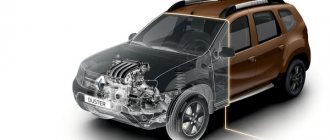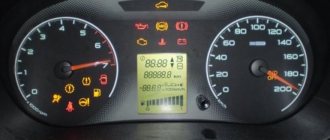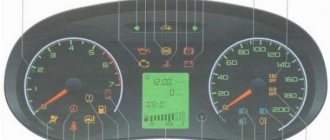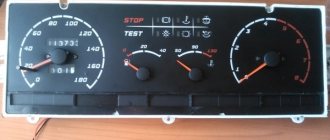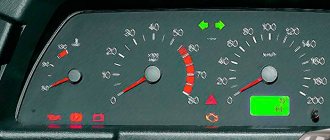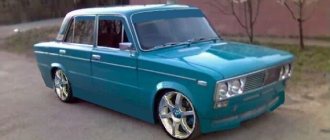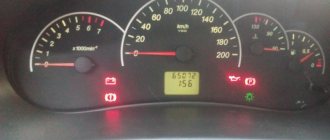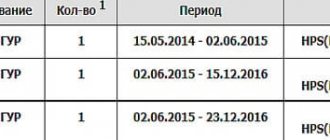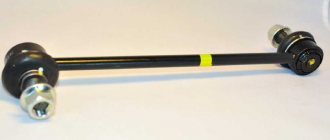The Solaris dashboard is equipped with an advanced driver alert system and indicators that meet stringent safety requirements. The abundance of indicators and tidy icons can confuse even an experienced user. For example, “ECO” signals are missing on most older cars, which necessitates the need to carefully study the owner’s manual when purchasing. But when purchasing a used car, you may not receive instructions. Below is a detailed description of all the elements of the board with a full transcript.
Hyundai Solaris dashboard: general information on icons
The Solaris dashboard is equipped with an advanced driver alert system and indicators that meet stringent safety requirements.
The abundance of indicators and tidy icons can confuse even an experienced user. For example, “ECO” signals are missing on most older cars, which necessitates the need to carefully study the owner’s manual when purchasing. But when purchasing a used car, you may not receive instructions. Below is a detailed description of all the elements of the board with a full explanation.
Hyundai Solaris: indicators on the instrument panel
There are several types of indicators that display the status of on-board systems in real time. Standard instruments have three types of indicators, separated by color.
- Green/blue. The indicators indicate the normal operation of external lighting devices and secondary equipment that is not directly related to the operation of the power plant.
- If the yellow or orange indicator lights up, this indicates the need for vehicle maintenance. Some indicators indicate that the coolant temperature has been exceeded or an alarm has been activated.
- If the red indicator lights up, urgent diagnostics or repair of the machine is required. In this case, further operation of the machine until the malfunction is eliminated is prohibited.
Stability systems
| Bulb | Meaning |
| If such lamps come on, they indicate that the vehicle stabilization system has been disabled. | |
| When these indicators appear, there may be a problem with the brake assist and stability control system. | |
| The anti-skid system does not work or does not function correctly. The vehicle drives without problems, the engine can function without problems, but the electronics do not work. | |
| Activation of the anti-skid system. The vehicle entered a road with a slippery surface. |
What does the icon on the Solaris dashboard mean?
Regardless of the year of manufacture, 2011, 2013 or 2022, the indication and appearance of the indicators are practically the same. Cars with a new body are equipped with standard instrumentation and all the bulbs, except for the ones added, will be identical. Globally, icons are divided into three types:
- index;
- warning;
- prohibiting movement.
The group breakdown looks like this.
- Notify the driver about the normal operation of standard systems.
- Warns the driver about problems that require intervention. This could be the activation of the TPMS system, the end of the fluid in the windshield washer reservoir, and others.
- When such icons flash, you must immediately stop the machine and fix the problem. Driving with a light on, such as check the engine or critical overheating of antifreeze, is strictly prohibited.
Information signs
Further explanation of the designations is given using the example of the 2018 model. At the same time, most of the points will coincide with indicators of other years.
| Appearance | Decoding |
| The engine operates in economy mode | |
| The car is on the handbrake; to start moving, you need to lower the handbrake lever. | |
| Stability control is operating normally or disabled depending on the indicator. | |
| The turn signals operate normally, depending on the position, the left or right arrow blinks. | |
| Has no relation to engine operation, indicates normal operation of high beam lamps. | |
| The side lights are on and working normally. | |
| Front/rear fog lights included. | |
| Manual transmission indicators. The first talks about the need to raise or lower the position for better fuel economy. The second is an indicator that displays the current position of the gearbox. | |
| A snowflake can be displayed in two versions and indicates that the road is icy and further movement requires increased attention and caution of the driver. | |
| The fuel level in the fuel tank is below the recommended minimum. Urgent refueling required. | |
| There is not enough fluid in the windshield washer reservoir. |
Danger signs
Such indicators appear if there is a serious reason for stopping. Emergency signs are red and often appear in conjunction with other symbols.
| Appearance | Decoding |
| The airbags are disabled or not working properly. | |
| Seat belts are not fastened. | |
| The oil pressure in the engine crankcase is below a critical level; it is urgent to stop and replenish the lubricant level. | |
| The traction control system is damaged or there is a malfunction in the units. Valid for versions up to 2015. | |
| The symbols mean that one/several doors are not closed. Starting movement is prohibited. | |
| The trunk is open - driving is not recommended. |
Fault warnings
The next group of icons indicates breakdowns of major systems or the need for urgent maintenance.
| View | Description |
| The immobilizer is activated and operates normally. If the lamp blinks, there is a failure in the system. | |
| The battery is discharged or there is a critical voltage drop in the on-board network. | |
| The engine is faulty. In the 2022 tidy, it is accompanied by a characteristic inscription. It may also light up with other indicators, which narrows the search range. | |
| The motor has overheated. You need to stop and wait until the system cools down. |
For diesel vehicles
Depending on the manufacturer, the bulbs may vary.
| Symbol | Designation |
| The indicator always appears when the ignition system is activated. After starting the power unit, the icon should disappear. If it continues to burn, this indicates a malfunction of the glow plugs. | |
| The particulate filter element is clogged or working normally. | |
| Lack of working fluid in the exhaust system. | |
| Problems in the functioning of exhaust gas cleaning devices. | |
| The presence of condensate in the fuel system, it is necessary to remove the liquid and check its performance. | |
| Problems with the electronic fuel injection control system. The car's power unit may function unstably, stall randomly, and not start. The appearance of the icon may be due to contamination of the fuel filter device, breakdown of the injectors or valve in the fuel pump. Also, the reason sometimes is airing of the fuel system. | |
| The control unit reports the detection of moisture in diesel fuel. The icon may indicate an error in the operation of the electronic powertrain control systems. | |
| Typically this indicator turns on when the ignition is turned on. If it continues to light after starting the engine, then the driver should know that the timing belt needs to be replaced as soon as possible. |
If you see the indicated symbols on the dashboard, then contact the dealer or car service directly as quickly as possible. Attention! Symbols (icons) are listed in order of importance, from severe to less severe warnings.
| The icon lights up along with a warning message on the instrument panel. In European cars, a yellow symbol(color) indicates a malfunction of the stability control system. | ||
| Airbag error. | ||
| Indicator of inactive side airbags. | ||
| Warning about unfastened seat belts for the driver and front passenger. | ||
| Warning about unfastened seat belts for rear passengers. | ||
| Car alarm indication/Immobilizer icon. | ||
| Gearbox error. Automatic transmission malfunction. | ||
| Warning about overheating of the automatic transmission or drive system. | ||
| Transmission overheating or clutch problem. | ||
| The oil temperature in the gearbox is too high. | ||
| Power steering malfunction. | ||
| Parking brake (handbrake). | ||
| Low brake fluid level. | ||
| Anti-lock braking system. | ||
| Brake pad wear symbol. | ||
| Problems with the electronic control of the brake system. | ||
| Malfunction of the electric parking brake (handbrake). | ||
| Warning that you must press the brake pedal before starting the engine or before shifting the gearbox. | ||
| Tire pressure monitoring system. If it appears, check the pressure. | ||
| Check Engine - Engine check. Read more here... | ||
| Check the engine electrical equipment. | ||
| Reduced engine power. | ||
| Engine malfunction. | ||
| Lambda probe. Oxygen sensor fault indicator. | ||
| The gas tank is not closed. Air in the fuel system. | ||
| A symbol indicating the presence of an information message in the system. | ||
| The need to read the vehicle's operating manual. | ||
| Overheating or malfunction of the catalyst. | ||
| Low coolant level. | ||
| Engine cooling problems / Low coolant level. | ||
| Problem with electronic throttle control system. | ||
| Air filter contamination indicator. | ||
Below we present the dashboard symbols that are used in diesel cars.
| Indication of glow plug operation. | ||
| DPF warning. | ||
| Warning about exhaust problems due to the particulate filter. | ||
| Water in the fuel system. | ||
Error icons on the Solaris dashboard
In self-diagnosis mode, the display may display one or more digital codes indicating problems in a certain part of the vehicle's wiring and on-board systems. The description of the codes is given using the example of a 2014 type ECU, taking into account the most common faults:
- 00 – systems are operating normally, there are no errors;
- 11/12 – the cabin thermometer is broken or a short circuit is detected in the circuit;
- 13/14 – similar for the outside temperature sensor;
- 17/18 – evaporator sensor circuit is disabled;
- 19/20 – the wiring of the damper drive/mixture potentiometer on the driver’s side is damaged;
- 21/22 – open circuit, short circuit/malfunction in the mode damper network;
- 25/26 – open/short circuit of the potentiometer of the specified device;
- 47 – malfunction of the engine speed sensor;
- 48 – the ABS system has detected incorrect rotation of one or more wheels;
- 49 – DTOZH error.
Possible malfunctions of the device and methods for eliminating them
This is a complex, reliable complex, characterized by unpretentiousness and rare breakdowns. However, problems happen here too. The main malfunctions are as follows.
- Broken or damaged arrow indicators. Eliminated by replacing the module or pointer drives.
- Indicator lamp burns out. The indicator on the instrument panel stops lighting. The problem is resolved by replacing the light bulb.
- Failure of relays, fuses. Can be repaired by standard workshop repairs.
- Short circuit of contact pins and connectors. A breakdown can lead to a complete replacement of the device. Resoldering leads reaches 50% of the cost of a new part.
Kalina
If a red exclamation symbol inscribed in a triangle lights up, this may indicate a malfunction of the brake drive. This is usually caused by a critical drop in fluid in the expansion tank. To eliminate the indicator, simply add the product to the required level.
Also on 2008 versions, the pointer may be accompanied by sound signals and additional lamps flash. This may be caused by a third-party option and can be specifically determined by checking the circuit.
If the light blinks, the reason is hidden in a system error or outgoing contacts. Diagnostics is performed by eliminating loose terminals and connecting a computer.
Procedure for removing and installing the tidy
To dismantle this part on Solaris, you must perform a sequence of actions.
- Disconnect the contacts from the battery.
- Unclip the center console of the media player. The part is attached to plastic latches and removed with a flat-head screwdriver.
- Disconnect the audio system unit (held on by 4 screws).
- Carefully unhook the wiring contacts.
- Next, unscrew the steering column covers and remove them.
- Using a wide screwdriver, release the fasteners of the facing part of the board.
- Underneath there are 4 bolts holding the instrument cluster - unscrew.
- Next, you will need to disconnect the wire terminals and completely remove the board from the machine.
Specialization : Graduated from the State Automobile University, worked for 20 years at GAZ-56, now I drive a Zhiguli.
Explanation of symbols on the dashboard.
We offer our readers the most complete list of symbols that can light up on the dashboard of cars. Modern cars have many gauges and sensors, as well as electronic engine control. All information from the sensors flows into the on-board computer of the car. In the event of any error, breakdown or other need to inform the driver of important information, automakers have provided a large number of signal symbols and inscriptions on the dashboard, which, under certain conditions, immediately light up.
Unfortunately for everyone, such a wide variety of signal symbols on the dashboard of a car confuses many of our drivers, and sometimes even just scares them. We have collected for you, dear readers, more than 150 signal symbols that are found in more than 2000 cars today. This review includes 30 automobile brands.
How to remove
Detailed algorithm for removing the supervision panel:
- First of all, in order to avoid a short circuit, you need to remove the negative terminal from the battery. To do this, you only need one key for 10.
- Now you can safely go into the salon, because all the work will be done here. Using a Phillips screwdriver, unscrew a pair of screws from the front panel that hold the plastic element and four that secure the protective glass. To avoid any difficulties, it is recommended to lower the steering wheel.
- The peculiarity of the Hyundai Solaris is that you need to pull out the frame along with the protective glass. It rests on specialized metal inserts, so you just need to pull it. This must be done carefully so as not to damage the shield itself.
- Remove the screws that secure the dashboard to the center console.
- Carefully pull out the supervision panel. There are light bulbs behind it, which should be replaced if necessary.
- As soon as new lamps are installed, it is necessary to turn on the lights to make sure that the control panel is working. If it is broken, the board is removed and completely repaired.
Actually, there is nothing supernatural about removing the dashboard on Solaris. If you have the time and desire, you can do everything yourself.
1200 rub. for the photo report
We pay for photo reports on car repairs. Earnings from 10,000 rubles/month.
Write:
Drivers are notified of the presence of malfunctions in various vehicle systems using icons on the instrument panel. It is not always possible to decipher the meaning of such burning icons intuitively, since not all car enthusiasts are well versed in cars. In addition, on different cars, the graphic designation of one icon itself may differ. It is worth noting that not every light on the panel only indicates a critical malfunction. The indication of light bulbs under the icons is divided into 3 groups by color:
Red icons indicate danger, and if any symbol lights up in this color, you should pay attention to the signal from the on-board computer in order to take measures to quickly resolve the malfunction. Sometimes they are not so critical, and it is possible to continue driving the car when such an icon on the panel is on, but sometimes it is not worth it.
Basic icons on the dashboard
Yellow indicators warn of a malfunction or the need to take some action to drive the car or service it.
The green lamps of the symbols inform about the vehicle’s service functions and their activity.
Let's present a list of the most frequently asked questions and an explanation of what the burning icon on the panel means.
Information displays on the dashboard for technical messages and warnings.
The following controls and instrumentation are located on the instrument panel
1 – the inner handle of the driver's door lock allows you to open the driver's door from inside the car.
2, 16 – control levers for exterior rear-view mirrors (on vehicles not equipped with electric drive for exterior rear-view mirrors).
3, 15 – side nozzles of the heating (air conditioning) and interior ventilation system. Designed to direct air flow from the heater (air conditioner) and ventilation system.
– mode of turning on the direction indicators. Move the lever up or down until the turn indicators turn on. When you move the lever up or down in the instrument cluster, the indicator 8 or 2 starts flashing, respectively. When the steering wheel returns to the straight-ahead position, the lever is automatically set to its original position.
– switching mode for low/high beam headlights. To switch the headlights from low to high.
move the lever away from you. In this case, indicator 13 will light up in the instrument cluster.
– mode of turning on the headlights. To turn on the headlights, turn handle “A” of the switch lever around its axis.
– the side lights in the front and rear lights are turned on, as well as the lighting of the instrument cluster;
– low or high beam headlights are on.
For signaling high beam headlights
push the switch lever towards the steering wheel;
– mode of turning on the fog lights and rear fog lamp.
– the rear fog lamp is on (only when the headlights or side lights are on), and indicator 12 will light up in the instrument cluster.
– the rear fog lamp is turned on, and indicator 12 lights up in the instrument cluster
– the fog lights and the rear fog lamp are turned on, in the instrument cluster additional indicators 14 and 12 light up, respectively
Depending on the vehicle configuration, a steering wheel may be installed with keys “A” and “B” for controlling the audio system and keys “B” for controlling a phone with Bluetooth function.
7 – ignition switch (lock)
or engine start and stop button (depending on configuration).
– LOCK (lock) – the ignition is turned off, the anti-theft device is turned on when the key is removed.
To remove the ignition key from a manual transmission vehicle, press and hold the key in the "ACC" (optional) position and turn it to the "LOCK" position. Then remove the key from the lock.
To remove the key from the ignition switch of a car with an automatic transmission, first move the gear selector lever to the “P” (parking) position, and then turn the key in the lock to the “LOCK” position. Remove the key from the ignition.
To ensure that the steering shaft is locked, turn the steering wheel to the right or left until it clicks.
To turn off the anti-theft device, insert the key into the ignition switch (press the engine start and stop button) and, turning the steering wheel slightly left and right, unlock it;
– ACC (additional equipment) – the ignition is turned off, the key is not removed, the steering is unlocked, the power circuits for the sound signal, exterior lighting, audio system, cigarette lighter, etc. are turned on.
To activate ACC mode on vehicles equipped with an engine start/stop button, press the start button once without depressing the clutch pedal for vehicles with a manual transmission; without pressing the brake pedal - for cars with an automatic transmission (the orange indicator light on the start button will light up).
– ON (on) – the ignition is on, the key is not removed, the steering is unlocked. The ignition, instruments and all electrical circuits are turned on.
To activate the “ON” mode on vehicles equipped with an engine start/stop button, press the start button twice without depressing the clutch pedal for vehicles with a manual transmission; without pressing the brake pedal - for cars with an automatic transmission (the blue indicator on the start button will light up);
– START (starter) – the ignition and starter are turned on, the key is not removed, the steering is unlocked. This key position is not fixed; when released, the key returns to the “ON” position under the force of the spring.
To start the engine on vehicles equipped with an engine start/stop button, press the start button once after depressing the clutch pedal for vehicles with a manual transmission; for cars with an automatic transmission - first depress the brake pedal and set the gear selector to the “P” or “N” position (the indicator does not light up).
8 – the windshield wiper and washer switch lever (right steering column switch) turns on the electrical circuits when the ignition is on.
The lever is moved up or down to the following positions
Car manufacturers have provided several types of such inscriptions and symbols on the dashboard, dividing them by color (color scheme). For example, if you see on the dashboard (on the dashboard) not a red icon-symbol, but, for example, green or blue, then your car is most likely still operating in normal mode and you can safely continue driving. But nevertheless, you should never ignore the appearance of any warning signal on the dashboard.
If a red symbol appears on this panel, the vehicle's electronic system is warning you in advance of a potential serious problem.
Distinctive features
The Supervision panel is divided into two subtypes. The usual one has a silver edging of the instrument wells, red illumination of the arrows, and partial blue illumination of the interior space.
Supervision 1 has backlit arrows in white, and the entire instrument area is illuminated in blue. In addition, when starting and stopping the engine, a welcome or farewell message appears on the on-board computer display: “Welcome Hyundai”, “Goodbye”.
Information displays on the dashboard for technical messages and warnings.
Over time, malfunctions may appear in the operation of the control panel:
- Failure of the device itself. If the shield breaks, there can be many signs of this. For example, all devices and instruments will refuse to work, or maybe only some of them. The car owner will have to check the unit for faults and repair it. Moreover, it is better to contact specialists for repairs, especially if you have never performed a similar task before. Moreover, it will not be possible to properly check the unit without the appropriate equipment.
- The backlight of the device has disappeared, but all equipment is working normally. If this is the case, then the reason is unlikely to lie in burnt-out light bulbs; most likely, it needs to be looked for in the fuses or cable. After all, it may be damaged - this can be diagnosed using a tester. If it turns out that the problem is with the cable, it needs to be changed.
- All or some of the indicator lights do not work. The problem can be caused either by a malfunction of the microcircuit itself, or by a burnt-out light bulb or a breakdown of one or another sensor. If the sensor fails, the lamp may remain on continuously. Burnt-out light bulbs should be replaced, and if you notice that there are oxidized contacts on the circuit, they need to be cleaned. Sometimes the reason lies in the contacts of the lamp socket being too loosely attached to the board; if this is the case, then the contacts just need to be bent.
- The speedometer refuses to work. In most cases, the reason lies precisely in the board itself, so it will be necessary to fully diagnose it before drawing any conclusions.
- The fuel level or coolant temperature controller refuses to work, or these devices work but show incorrect data. First of all, you need to check the sensors - sometimes they fail, sometimes the wiring breaks, and in some cases the reason, again, lies in acidified contacts. If the regulator breaks down, the device must be replaced with a new one, if the wiring is broken, the wire must be changed, and if the contacts are oxidized, the terminals must simply be cleaned (the author of the video is Sergey Zhuravlev).
The need to remove the instrument panel can be caused by a variety of reasons.
The panel on the Hyundai Solaris does not work well or has completely failed. As a rule, in such a situation, some of the indicators cease to function. The owner of the car will have to check the unit for faults. It is better to entrust the procedure to the masters, because they have specialized equipment.
The dashboard on the Hyundai Solaris car operates without backlight. It is extremely rare that the cause is burnt out light bulbs. It's the cable or the fuse. Diagnostics is carried out using a tester, which, again, is available from specialists.
One or more indicators do not work. Here the issue could be either the light bulbs or the failure of the microcircuit. Such a breakdown can also be caused by problems with the sensor. Also, if there are problems with the full functioning of the fuel level and temperature controllers, it is necessary to check their sensors. You can do the same in the case of a speedometer failure.
Quite often the contacts in sensors oxidize, which is a simple and quick fix. In addition, you do not have to remove the tidy. You shouldn’t discount the option that the tidy may simply creak, and this is most often a factory defect, or the screws have become loose due to vibrations.
Methods for diagnosing the computer. Solaris firmware via OBD2
There are several options for electronic service:
To activate the self-diagnosis mode, you must perform the following sequence of actions:
- Turn on the ignition and wait 3 seconds (without starting the engine).
- In the next 5 seconds, press the gas pedal all the way 5 times.
- Release the pedal and wait 7 seconds.
- Press the accelerator again until it stops until the CHECK indicator lights up.
- Release the pedal and read the fault codes (if present).
Solaris provides the following visual warning system: 4 series of 10 flickers indicate that there are no stored faults in the ECU (code 0000).
An example of decoding code 0103: a series of 10-1-10-3 indicator flashes, followed by a pause. Thus, any value is decrypted. After the pause, the second code follows if it is stored in the block ROM. When the list of values is completed, the ECU will repeat the display cycle again until the ignition is turned off.
The memory of the electronic unit can also be polled by external devices - scanners and adapters. The devices allow for a more in-depth analysis of vehicle components, control and safety systems. Using scanners, you can determine the frequency of occurrence of errors, as well as identify irregular malfunctions of electronic circuits.
Solaris memory is read through the OBD2 service connector. The scanner converts the flow of information packets, transforming them into an optimal form for service software.
Reviews of diagnostic scanners for Hyundai Solaris
Read detailed articles on the review of car scanners, including those compatible with the Hyundai Solaris.
Reviews of OBD2 diagnostic car scanners
This section provides descriptions of diagnostic scanners and adapters. Before purchasing a scanner for your car, it is recommended that you read reviews of the most popular equipment models.
The procedure for updating the internal software core is performed through programmers. The OpenPort 2.0 adapter is suitable for the Solaris model. There is also support for PCM flash, which acts as a reader of the ECU core.
For the procedure you will need:
- laptop with pre-installed Windows OS;
- Software for downloading dump file;
- new firmware version;
- chargers: for car and computer.
The bootloader is J2534 HmeSetup, which can be downloaded from the official website. Please note: This version is suitable for European Solaris types. Before downloading, you must install the J2534 adapter drivers, which open the port for OpenPort.
The firmware update process is automatic. But it is necessary to ensure a stable charge of the car and computer batteries. Power interruptions are strictly not allowed - complete failure of the ECU is possible.
Lighting icons and symbols in cars.
Below are all the lights on your dashboard that are related to your vehicle's lighting system. Many of us have probably seen many icons and symbols in our cars. Most of them light up green or blue.
Headlight fault symbols.
High beam on icon.
Automatic low beam system activated. Light sensor.
Automatic high beam control system.
Headlight alignment icon. If it lights up, then diagnostics is necessary.
Daytime running lights indicator.
Faulty light bulb in the rear headlights.
Rear fog lamp symbol.
Arrows indicating that the turn signals are working or the hazard lights are on.
Color
Colors that have icons on the dashboard:
- The red color of the symbols indicates possible serious malfunctions or an unresolved vehicle safety issue. In addition, red symbols are often used as reminders, for example to apply the parking brake.
- The orange or yellow color of the indicators indicates that a particular component or mechanism of the vehicle needs maintenance and even repair. As practice shows, in most cases, when the orange symbol flashes, the driver needs to seek help from a specialist as quickly as possible or diagnose the unit.
- Green or blue colors are usually used only to inform the driver that the function is activated and everything is working normally. In principle, you can finish this point and move on to decoding. You should start with more important and serious indicators and designations.
About the indicators on the dashboard
1 - Tachometer. This is the name of the device that shows the number of revolutions of the crankshaft.
2 — Turn signal lamps. They are activated when you use the switch located under the steering wheel.
4 - Counter showing mileage for 24 hours.
6 — Fuel level controller in the tank.
7 - Sensor that shows the coolant temperature.
8 - Indicator indicating an open door.
10 - Handbrake indicator. If it lights up while driving, you need to check the brake fluid level.
11 — Battery charge level icon
12 – Lamp indicating that the seat belt is not fastened.
13 — Engine oil pressure indicator.
14 - Symbol that lights up when the amount of fuel is low.
15 - MIL. The icon appears if the ECU recognizes a malfunction in the engine.
17 - Icon indicating automatic gear shifting.
18 — Passive safety system light.
19 — Distant color switching indicator.
In what other cases does the exclamation mark light up?
If the fuel pressure is at a normal level, and the brake pads do not cause any complaints, but the indicator warning sign is still on on the panel, then what could this mean? In such a case, it is worth assuming that something is happening with the wiring: the system most likely began to open. If any wire leading to the pad sensor breaks, a lamp lights up, signaling their wear. In this case, of course, you can short-circuit the wires yourself, but then you will have to climb under the car every 2000-3000 km to check their condition. So it’s better to go to the service.
